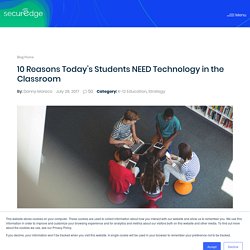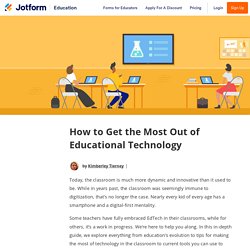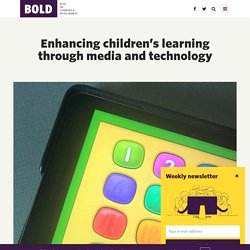

Educational Technology Resources for Teachers (Grades K-12) 7 Ways Technology Is Impacting Modern Education. Technology in the classroom can be so much more and so much better than the stereotypical cell phone going off in the middle of class. Technology can actually be a major tool, both in terms of pedagogical resources and in terms of connecting with the younger generations. But how does this work? The top seven important concepts to understand when examining the use of technology for educational or instructional purposes include: 1) Active engagement with the learning material. Technology is interactive, and students learn by doing, researching, and receiving feedback. 2) Use of real-world issues. 3) Simulation and modeling. 4) Discussion and debate boards and forums. 5) Working groups. 6) Coaching. 7) Formative assessment.
Teaching is all about introducing students to a whole world of concepts that they didn’t know about yet. Edtech: Know more about using technology in education. “If we teach today’s students as we taught yesterday’s, we rob them of tomorrow.”

John Dewey Teaching practices in schools are constantly evolving, but one thing remains unchanged; a child’s personal development is inherently linked to their school education. Teachers work incredibly hard to deliver positive results, develop effective assessment practices and engage their pupils throughout the day. Yet teaching is challenging; higher expectations are being placed on educators, with the requirement for more paperwork and in-depth administrative duties. While the concept of school education has remained, on the most part, the same for centuries, new technologies and smarter devices are emerging in schools. Edtech is disrupting traditional learning practices. But what exactly is edtech? What is edtech? Education technology — or edtech — is any form of digital learning, application, online or mobile learning platform, software or device available for the modern learning environment.
10 Reasons Today’s Students NEED Technology in the Classroom. Technology is everywhere--entwined in almost every part of our culture.

It affects how we live, work, play, and most importantly learn. With mobile and other wireless devices like the IoT becoming an increasing requirement across every industry today, it only makes sense that our schools are also effectively deploying mobile technology in the classroom. However, for many schools, implementing the latest technology is a difficult strategy to navigate. There are two main reasons for this: Schools are on the fence about the use of certain mobile devices; thinking they're more a burden than a strategic learning tool. Schools want to deploy mobile devices but their WiFi networks are not capable of properly supporting the technology In both cases it's a lose lose situation for everyone involved, especially the students.
To help your school confidently make the decision to embrace mobile technology in the classroom, we've put together a list of 10 reasons why it will benefit your students. A People-Centered Approach to Using Technology for Learning. How to Get the Most Out of Educational Technology. What innovations are big in the EdTech market?

Education Technology Tools for Teachers. Massive Open Online Courses make it possible for students of all ages to access high-quality coursework at no cost. Colleges and universities across the country publish video lectures, podcasts, reading lists, practice exams and more for anyone who wants to learn about a particular subject and/or experience what it’s like to take a college class.
Over the last decade, organizations such as Coursera and Khan Academy have taken MOOCs one step further by creating or aggregating thousands of free courses in areas ranging from early American history and civics to trigonometry and multivariable calculus. Khan Academy is a non-profit educational website created by educator Salman Khan in 2006. Khan, a graduate of MIT and Harvard Business School wanted to provide a free world-class education for anyone anywhere. Why Use Technology? Use of Technology in Teaching and Learning. Technology ushers in fundamental structural changes that can be integral to achieving significant improvements in productivity.
Used to support both teaching and learning, technology infuses classrooms with digital learning tools, such as computers and hand held devices; expands course offerings, experiences, and learning materials; supports learning 24 hours a day, 7 days a week; builds 21st century skills; increases student engagement and motivation; and accelerates learning. Technology also has the power to transform teaching by ushering in a new model of connected teaching. This model links teachers to their students and to professional content, resources, and systems to help them improve their own instruction and personalize learning. The links on this page are provided for users convenience and are not an endorsement. See full disclaimer. Full-time online schools: The following online or virtual schools enroll students on a full-time basis. State operated District operated.
Enhancing children’s learning through media and technology. That being said, this brings up a lot of questions.

Are electronic storybooks actually helping children learn new vocabulary? Do children remember and learn from the lessons shown on Sesame Street? Are apps that are labelled as “educational” actually helping children to learn? A recent report in 2017 surveyed approximately 1400 parents living in the US to determine the patterns of media use among children between 0 and 8 years.